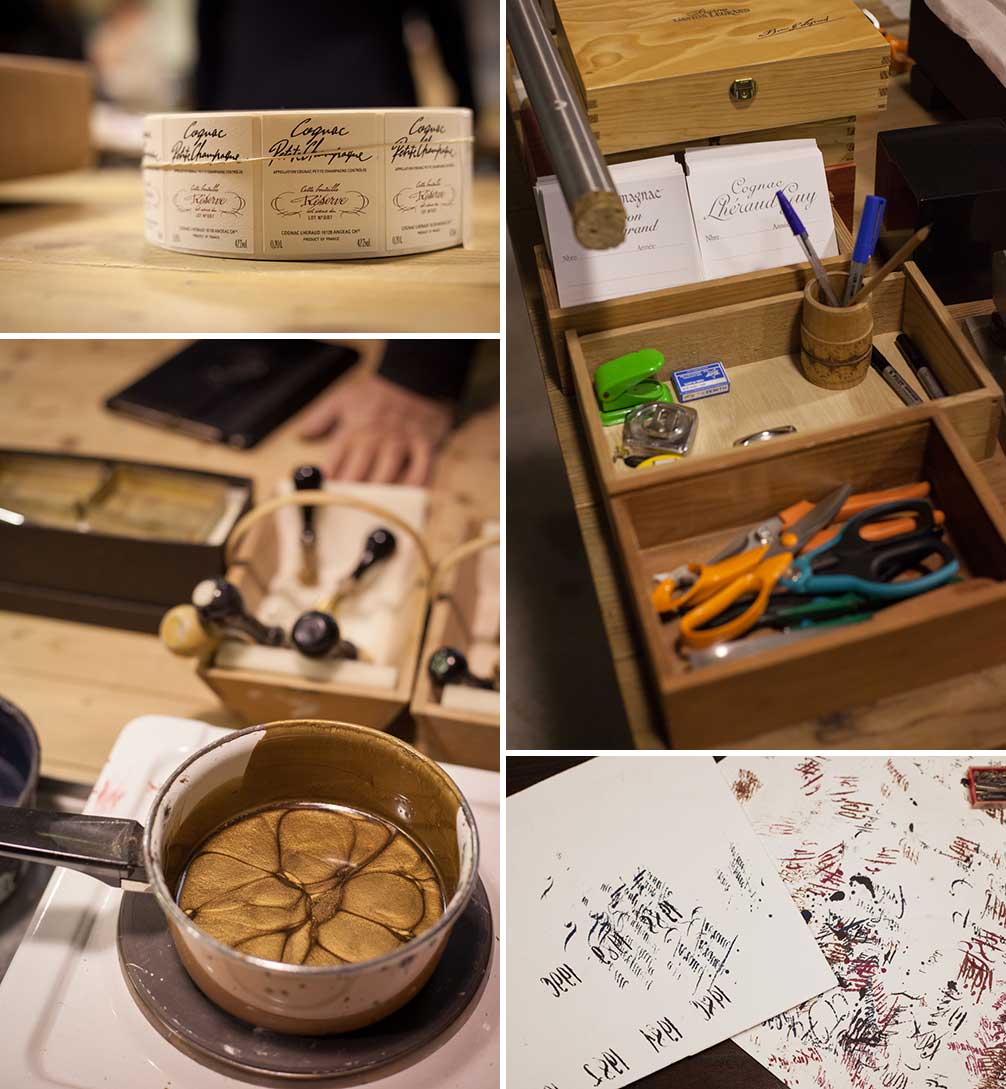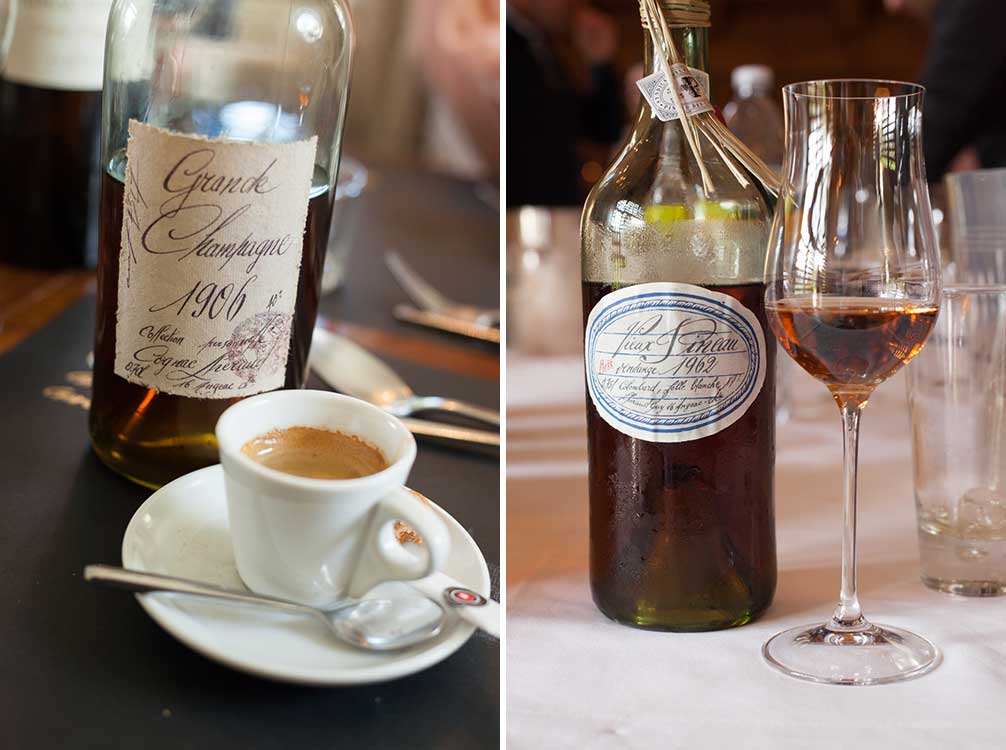Guy Lhéraud doesn’t speak a word of English. He doesn’t want to, nor does he need to. When I met him in April, his expressive hands conveyed at least half of what he was saying.
On that gray spring day, Guy spent the first 15 minutes telling our group — through a translator — that we didn’t have enough time. We were Americans, and it was typical of us to rush things. We ate enormous burgers then stressed out over burning the calories. We were strange creatures. How could we only visit for a few hours and expect to understand Cognac? We needed to spend weeks if we wanted to understand it.

Half an hour into our four-hour visit, he finally started talking Cognac, but invariably, the presentation would go astray.
Like when he scoffed at “farm-to-table” cuisine.
“For centuries, we eat everything from here,” François Rebel, Cognac Lhéraud’s Export Manager, translated for us. “The ducks, the pork, the vegetables. We make everything but the salt and pepper.”
Guy then showed us where he was curing an entire pig in salt (with a few splashes of Cognac throughout the week), all while dragging on an omnipresent cigarette. I almost asked if he made the cigarettes, but decide against it.
Creativity from History
Appreciating the beautiful oddities of Cognac Lhéraud is not hard to do. For me, it started before we had a single sip of their signature drink. There was an invigorating sense of creativity to their operation, even under the fluorescent-lit lights of the sterile warehouse, where recently bottled vintages — some stretching back decades — lined the same warehouse shelves you expect to see at Costco.
I’ve never witnessed a type of creativity like this before: it appears to be fueled entirely by stubbornness. A resistance to change that embraces the past, and therefore, the beautiful old way of doing things. It’s evident in the faded wood of the barrels, the copper-pot stills that look like mid-19th century technology, and most of all, in the beautiful packaging.

Andrée Lhéraud, Guy’s wife, still handwrites each label for their vintage Cognac, in an elegant path of black ink that is as much a timeline as it is the written word. She even makes the ink herself from acorns. The labels are then ironed onto the bottles, the seal made from wax on a nearby stovetop. In a world where fast-food franchises have seemingly stripped the word “handmade” of all meaning, the little bottles of vintage Grande Champagne and Petite Champagne Cognac at Cognac Lhéraud are a small restoration of sorts — a testament to doing everything by hand.
They are also a fat middle finger to our rushed way of modern life.
“We have nothing against computers,” François notes. “Computers make fine Cognac. It is just that they all taste the same. There is no character.”
“If you want to make something of quality,” Guy adds, which François’ then translates. “You must give time to time.”
It is the sort of mentality that helped save Cognac Lhéraud from bankruptcy in the 1960s. It was then that Andrée discovered her gift, and the novelty of the labels helped fuel sales and introduce the quality of their small-batch Cognac to a new generation of clients. Guy counts the Prince of Monaco as one of their fans; on a wall in their office is a photograph of the prince with Guy and Andrée. A nearby calligraphy set was a gift from him.

Standing out and embracing tradition — even in the labeling — has helped Cognac Lhéraud avoid the fate of many Cognac producers. According to François, large brands like Hennisey, Martell and Rémy Martin call the shots around Cognac.
“[Cognac] is dominated by four big brands, and they buy up all the juice from the vineyard,” he had told me the day before as we drove through the Charente countryside. “Then they squeeze the farmers and their families by insisting that they improve their cellar and facilities to ridiculous standards. Of course, the farmers can’t afford this, and the brands know this, so they say ‘we will no longer buy your juice, unless you sell your farm to us.'”
Where Were You in 1962?
Cognac is a form of brandy that falls under the French Appellation d’origine contrôlée designation. It can only be made within a defined area of the Charente and Charente-Maritime departments, located some 70 miles north of Bordeaux. Made from the Ugni Blanc grape — and in the case of Cognac Lhéraud, with small portions of the historic Folle Blanche and Colombard grapes — it is double-distilled in copper pots then aged in oak casks. Unlike wine, its character does not change with age once it is bottled.
But I will admit that I did not come to France to drink Cognac. I came to drink wine. The press trip that got me there — funded by the importer Wilson Daniels — just happened to start in Cognac. At first, I was along for the ride, biding my time until we reached Champagne, Burgundy, Beaujolais and Provence. My apprehension about Cognac stemmed only from a personal aversion to all-things-distilled. I don’t have a good track-record of handling high-alcohol levels.
But as our tour reached the tasting — and soon after, the ancient cellar — I fell under Cognac’s spell.

In a grand salon off the estate’s courtyard, I got my first taste: a sip of the 1962 Pineau des Charentes, a hybrid of Cognac and wine in which unfermented grape juice is mixed in with the eaux-de-vies in barrel, allowing them to age together and create a slightly fruiter, yet no-less-poignant drink. At 17% alcohol, it was right in my comfort zone, and utterly delicious recalling raisins, hazelnuts and charred wood. Rare in the United States, it was even more uncommon to sip one with such substantial age.
And this was just the warm-up act.
124 Years in a Single Sip
We sampled a few more Cognac, ultimately arriving at a Grand Champagne from 1906 — until that point in my life, the oldest vintage of anything I had ever consumed. From then on, it was clear that tasting notes were inadequate. Yes, it recalled hazelnuts again, as well as dried apricots and even rum, but it was the liveliness to the 111-year-old Cognac that was most noteworthy. This was a drink to awaken every corner of the senses, and it went down with a substantial burn of alcohol and — I couldn’t help but notice — history. Through World War I, World War II, the Cold War, and the entirety of my 38 years, it had been sluggishly transforming in a barrel, sometimes with battlefields raging nearby, waiting for the moment when it would touch someone’s palate. Perhaps the burn in my throat was guilt.
The feeling would be amplified moments later when we walked into a small, stony parlor room just off Guy’s home. Dating from the 9th century, the building was once used by the Knights Templar, as evidenced by their symbol — the heart — made of embedded stone on the floor. Situated along the Paris-borne spur of the Camino de Santiago, the home had also been an inn for those walking the route. “If you brought a stone from the river, you would receive board,” François told me, pointing at the tiny stones that now comprised the floor. They had been worn to a smooth polish by the footsteps of centuries gone by.

At the back of the room was a cavernous entry, which lead to a dusty, cobweb-covered cellar. In the gloomy light, an army of glass demijohns and bottles appeared, each labeled in a signature scrawl that predated Andrée’s handwriting, yet no less looked similar.
“Grand Champagne 1873.”
“Armagnac 1965.”
“Année 1865.”
And oldest of all, a canvas jug with a chalkboard that simply read “1802.” The contents of the jug bore special significance to the Lhéraud family: that was the family’s first vintage.
“We live and die for Cognac,” Guy said. And soon, he had acquired a plastic tube for siphoning. Removing the stopper and canvas-like cloth from the neck of a demijohn labeled “Petite Champagne 1893,” he siphoned a sip for me. This would be the oldest drink of my life, and the burn it carried was like holding sunshine in your chest for several minutes. Traces similar to dried apricots, rum raisin, walnuts and vanilla lingered, and lingered … and lingered.

What just happened? I finally asked no one in particular.
It took a moment outside for me to sort it out in my head. Guy Lhéraud — whose family had lived in that stone house since 1680, and who moments earlier had typecast all of us as impatient ghosts running through life with a hamburger in hand — had generously given me a portion of his family history to take with me.
“If you want to make something of quality, you must give time to time.” The gravelly voiced distiller had not just given me words to live by, but liquid proof to back it up.
Note: This article was made possible by my attendance on a press trip coordinated by Wilson Daniels. Learn more about my editorial policy.





I want to take notes of YOUR notes, that’s how layered and interesting this is. Don’t you feel, when invited in, that ‘blessed’ is just a tiny smidge of a word?
And a smile here: “Computers make fine Cognac…”
What a trip!
Thanks Jill. This was a hard piece to start writing because my “expertise” on Cognac is close to nil. But that became the point. And it didn’t seem to matter that if Guy and François quizzed me on Cognac, I would have failed. They just wanted to share the family’s story, and the massive stretch of history their Cognac encompassed. It was very moving.
Thanks for welcoming this story into your life. Cheers!